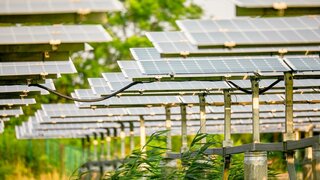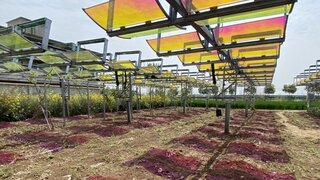Tapping the Potential of Agrivoltaics in China to Reach Climate Goals
Agrivoltaics (APV) is the dual use of arable land for agricultural activities and solar power generation. Typically, this involves the construction of photovoltaic modules on farmland. In densely populated countries with scarce accessible land resources like China, APV has the potential to greatly contribute to the expansion of decentralised renewable energy and accelerate the energy transition. By providing an alternative source of income for local farmers, APV can contribute to the sustainable development of rural areas. Partnering with the China New Energy Chamber of Commerce, the Energy Partnership worked towards creating a sustainable framework for APV development.

In China: Despite having the largest installed capacity of APV worldwide, lacking regulation led to a poor execution of many APV projects. As electricity production requires less work than growing crops, and in the absence of standards requiring certain levels of produce, operators often place a high emphasis on electricity generation, while little or no consideration is given to maintaining crop yields. With arable land being a precious resource, fears of APV reducing food production pushed some provincial governments in China (e.g., Shandong, Henan) to halt further APV construction in summer 2022.
In Germany: Over the decades of promoting the energy transition, Germany has accumulated extensive experience in decentralised renewable energy, as well as APV. According to experts from Fraunhofer ISE, 1700 GWp of solar power capacity could be added to the grid by constructing APV on 4% of farmland in Germany. The recently established industry standard is instrumental in harnessing this potential. It defines a minimum yield, requirements for the structure (e.g., in terms of removability), and includes two classifications dependent on the height and land occupancy rate of the solar arrays. First subsidised projects from 2022 are bound to this standard.
Our goal
Recognising its great potential in expanding renewables, the Sino-German Energy Partnership is committed to support a sustainable development of APV in China. As the name implies, agriculture comes first in agrivoltaics – with electricity production as a welcome addition. The Energy Partnership supports Chinese authorities to develop the technical and legal framework for developing APV without negative impact on food production. In practical terms, this means the development of standards and the adjustment of national and local legal frameworks.
Our activities & results
Facilitate technical exchange
To better understand the status quo of APV development in China, the Energy Partnership set focus on facilitating initial technical exchange between Chinese and German stakeholders and providing policy recommendations. One highlight was the Sino-German Expert Workshop on Agrivoltaics Development in China in August 2022. Representatives of NEA, Fraunhofer ISE, German and Chinese companies and associations exchanged information about the political framework of both countries. Apart from German standard for APV and APV projects in Germany and China, the best practice of the Indo-German Energy Forum provided further inputs for reference.
Provide policy recommendations & support standard development
The Energy Partnership has developed policy recommendations for Chinese authorities to improve the industry environment for APV and commissioned a report on the development status of APV in China. The report provides an overview of APV capacity distribution, financing types, and crop selection for APV projects, and concludes with policy recommendations such as developing a standard, resolving land use conflicts, and creating economic incentives for developers. The Energy Partnership has translated the German standard for APV into Chinese to support standard development in China.
Impact and further action
In autumn 2022, the NEA declared the commitment to supporting APV development in China, which will be supported by NDRC and the Ministry for Natural Resources (MNR). This marks a significant milestone in bringing different ministries together to work towards a mutual understanding of the importance of APV. The statement includes plans to adjust local land-use policy and to develop a standard, demonstrating a coordinated effort to promote the growth of APV in China.
In response to the growing demands and calls from the APV industry in China, the NEA has announced the development of an industry standard for composite PV projects in 2023. The Sino-German Energy Partnership, in collaboration with its Chinese partner, CREEI, will contribute to the standard development. In this process, the interests and demands of German companies in the Chinese APV market will also be considered and discussed.
Innovative Approach from China for mutual learning: Spectrally Separated Agrivoltaics Systems

The China Academy of Science in Hefei developed an innovative solution to increase the utilisation of sunlight at agrivoltaics sites. The basic principle of the spectrally separated agrivoltaics systems is wavelength division. By dividing the sunlight into two parts, one can be used for plant growth and the other for solar power generation. Using bended glass panels covered with multi-layer interference films, certain wavelengths used in photosynthesis are filtered and transmitted through the panel and onto the crops. The remaining sunlight is reflected to solar cells for power generation. A dual tracking system ensures full efficiency throughout the day and yearly seasons, while the crops always receive the light necessary for successful growth.